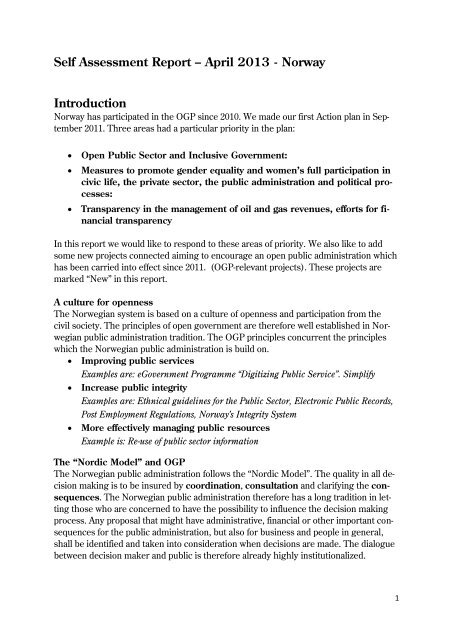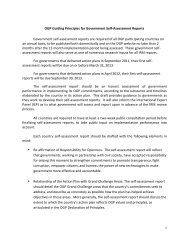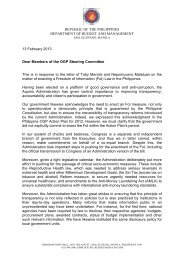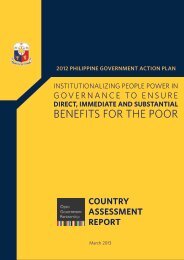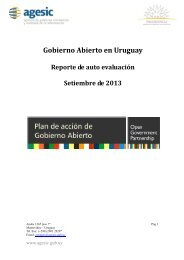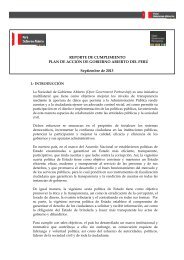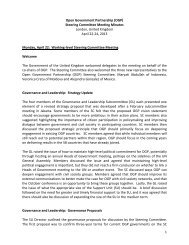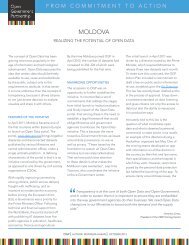Self Assessment Report 2013.pdf - Open Government Partnership
Self Assessment Report 2013.pdf - Open Government Partnership
Self Assessment Report 2013.pdf - Open Government Partnership
You also want an ePaper? Increase the reach of your titles
YUMPU automatically turns print PDFs into web optimized ePapers that Google loves.
<strong>Self</strong> <strong>Assessment</strong> <strong>Report</strong> – April 2013 - Norway<br />
Introduction<br />
Norway has participated in the OGP since 2010. We made our first Action plan in September<br />
2011. Three areas had a particular priority in the plan:<br />
<br />
<br />
<br />
<strong>Open</strong> Public Sector and Inclusive <strong>Government</strong>:<br />
Measures to promote gender equality and women’s full participation in<br />
civic life, the private sector, the public administration and political processes:<br />
Transparency in the management of oil and gas revenues, efforts for financial<br />
transparency<br />
In this report we would like to respond to these areas of priority. We also like to add<br />
some new projects connected aiming to encourage an open public administration which<br />
has been carried into effect since 2011. (OGP-relevant projects). These projects are<br />
marked “New” in this report.<br />
A culture for openness<br />
The Norwegian system is based on a culture of openness and participation from the<br />
civil society. The principles of open government are therefore well established in Norwegian<br />
public administration tradition. The OGP principles concurrent the principles<br />
which the Norwegian public administration is build on.<br />
Improving public services<br />
<br />
<br />
Examples are: e<strong>Government</strong> Programme “Digitizing Public Service”. Simplify<br />
Increase public integrity<br />
Examples are: Ethnical guidelines for the Public Sector, Electronic Public Records,<br />
Post Employment Regulations, Norway’s Integrity System<br />
More effectively managing public resources<br />
Example is: Re-use of public sector information<br />
The “Nordic Model” and OGP<br />
The Norwegian public administration follows the “Nordic Model”. The quality in all decision<br />
making is to be insured by coordination, consultation and clarifying the consequences.<br />
The Norwegian public administration therefore has a long tradition in letting<br />
those who are concerned to have the possibility to influence the decision making<br />
process. Any proposal that might have administrative, financial or other important consequences<br />
for the public administration, but also for business and people in general,<br />
shall be identified and taken into consideration when decisions are made. The dialogue<br />
between decision maker and public is therefore already highly institutionalized.<br />
1
How we made and how we followed up the action plan<br />
The work with the Action Plan started in August 2011 with mainly three to four ministries.<br />
The minister in charge was originally the Minister of International Development<br />
in the Ministry of Foreign Affairs.<br />
From this year on the responsibility has been taken over by the Ministry of <strong>Government</strong><br />
Administration, Reform and Church Affairs. The Ministry of Foreign Affairs still<br />
has the responsibility for financial questions connected with Norwegian participation.<br />
For Norway it was important to emphasize ongoing processes or processes to be started<br />
when we put together our plan. We stared with an information meeting at 12 th September<br />
2011 where about 20 NGOs participated. The plan was launched shortly after.<br />
On May 9 th 2012 the Ministry of Foreign Affairs / Ministry of Development invited other<br />
ministries to a meeting for discussing how to follow up the commitments in the Action<br />
Plan.<br />
<strong>Self</strong> <strong>Assessment</strong> <strong>Report</strong> submitted to civil society<br />
A draft of this report has been submitted to those organizations which participated at<br />
the information meeting in October 2011. Only one organization “Frivillighet Norge”<br />
(Association of NGOs in Norway) made any comments to the report. They see the plan<br />
as emphasizing too much on the individual citizen and not enough on the organized<br />
society.<br />
Three priority areas<br />
1) <strong>Open</strong> Public Sector and Inclusive <strong>Government</strong><br />
I. Develop digital public services<br />
‣ e<strong>Government</strong> Programme “Digitizing Public Service” (New)<br />
The Norwegian e<strong>Government</strong> Programme ”Digitizing Public Service” was presented by<br />
The Prime Minister and The Minister of <strong>Government</strong> Administration, Reform and<br />
Church Affairs in April 2012.<br />
The objectives of the <strong>Government</strong> are that:<br />
‣ the public sector is to be accessible online to the extent possible<br />
‣ web-based services are to be the general rule for the public sector’s communication<br />
with citizens and businesses<br />
‣ a digital public sector is to result in improved services<br />
‣ digitization of the public sector is to free up resources for areas in need of more<br />
resources<br />
The initiative represents raised ambitions in how the <strong>Government</strong> will draw upon ICT to<br />
reform the public sector. The following principles form the basis:<br />
1. The public sector is to provide unified and user-friendly digital services<br />
2. Login to public web services is to be simple and secure<br />
2
3. All citizens and businesses will receive mail from the public sector in a secure digital<br />
mailbox<br />
4. Citizens and businesses will be notified via SMS text messages and e-mail<br />
5. Necessary assistance is to be provided to citizens to ensure they will be able to find<br />
and to use digital services<br />
6. Development of ICT solutions is to be viewed in the context of the public sector’s<br />
work processes and organization<br />
7. Protection of privacy and information security are to be safeguarded<br />
8. Digitization measures of relevance for several services are to be coordinated<br />
Examples of projects and actions which are taken under the initiative include the following:<br />
- Getting rid of paper-based forms: by 2014/2015, forms will be available for the<br />
citizen to complete and submit digitally<br />
- By 2014, every citizen will have access to a personal digital mailbox in which all<br />
mail from public agencies is received. Unlike ordinary e-mail, this mailbox will<br />
have a level of security which is appropriate even for sensitive information, e.g.<br />
personal health data. Individual citizens can choose to stick to traditional, paperbased<br />
mail.<br />
- Legislation is being revised to allow for digital communication between public<br />
agencies and citizens/businesses.<br />
Digitizing public sector services Norwegian e<strong>Government</strong> Program is found under:<br />
http://www.regjeringen.no/upload/FAD/Kampanje/DAN/Regjeringensdigitaliserings<br />
program/digit_prg_eng.pdf)<br />
‣ Re-use of public sector information (PSI)<br />
Commitment:<br />
“All state enterprises are required to make public data available so that it can be used by<br />
others, i.e. it is published electronically in a user-friendly format.”<br />
Norwegian public administration is working hard to release the potential within PSI. All<br />
subordinated agencies are ordered by a common instruction given by the government<br />
to make suitable and existing accessible data available.<br />
There are several reasons for proliferation of open data:<br />
Efficiency and Innovation: Knowledge is shared both within and across the public<br />
and private sectors. Sharing public data will facilitate more coordination and creativity.<br />
Democratization: With open data the citizens have easier access to the basis for<br />
decisions and priorities in the public sector. An open culture may include a larger<br />
audience in the political processes.<br />
Transparency: With open data gets all broader understanding of public processes.<br />
This can help to boost confidence in the public sector and the political system.<br />
3
If data are open and available, citizens will have an opportunity to see both on what and<br />
how their tax money is being spent.<br />
For assisting public agencies there has been developed different tools to buffer<br />
the processes and relieve the PS bodies from any potential uncertainty they may<br />
have, be that legal, technical or administrative ones.<br />
Amongst the tools that are provided, are:<br />
Guidelines that gives an introduction to the hows and whys on making PSI accessible<br />
A standardized license that is intended for use when public entities distribute data<br />
and other relevant content for further use by business and industry as well as<br />
civilian society.<br />
A Data Hotel, a free service from Difi 1 , where data owners are able to publish<br />
their data without having to invest in new infrastructure or software<br />
Address: data.norge.no<br />
II.<br />
Develop the <strong>Government</strong> Communication Policy<br />
“The Plain Language Project”<br />
‣ The Plain Language Project in Norway’s Civil Service (2009 – 2012)<br />
Commitment: “all state enterprises are required to make public data available so that it<br />
can be used by others, i.e. it is published electronically in a user-friendly format”.<br />
Surveys showed that one out of three Norwegians had problems understanding governmental<br />
documents, like letters and forms. This was the background of the governments<br />
“Plain language”-project. The aim of the project was a significant improvement of<br />
the language in public document and more understandable forms.<br />
The project was coordinated by the Ministry of <strong>Government</strong> Administration, Reform<br />
and Church Affairs (FAD), but carried out in practice through a joint venture between<br />
two agencies:<br />
The Agency for Public Management and e<strong>Government</strong> (Difi)<br />
http://www.difi.no/artikkel/2009/11/about-difi<br />
The Language Council of Norway<br />
www.sprakradet.no/Toppmeny/Om-oss/English-and-other-languages/<br />
The project used different policy instruments:<br />
A web-based toolbox for civil servants, www.klarsprak.no: The toolbox includes<br />
advice, tools and tips on how written language can be made more userfriendly,<br />
clear and understandable. In addition, users of the web site can find in-<br />
1 Agency for Public Management and e<strong>Government</strong> (Difi)<br />
4
formation on how to carry out language projects in public agencies. English version<br />
of website: http://www.sprakradet.no/Klarsprak/Diverse/Toppmeny5/In-<br />
English/<br />
Courses: Civil servants are given the opportunity to attend courses on how to<br />
write clearly. The project group has also created a specific course for people<br />
wanting to start language improvement projects within their workplaces.<br />
Project grants and support: Public agencies can apply for funding towards<br />
language improvement projects. Public agencies can also receive practical support<br />
in the form of advice from Difi and the Language Council of Norway.<br />
Plain Language Prize: FAD awards an annual prize to the public agency which<br />
has worked best to improve its written information. The prize aims to encourage<br />
agencies to continue their efforts in using good, clear language. The prize has<br />
been awarded four times, last time to the Norwegian Public Roads Administration<br />
www.vegvesen.no/en/Home<br />
Surveys and documentation: The project has gathered findings from relevant<br />
surveys, research and other documentation about language used by the Norwegian<br />
Civil Service. The findings are published on the website.<br />
Experience from language improvement projects: The project «Plain Language<br />
in Norway’s Civil Service» has reviewed a number of other government<br />
language projects and published findings from these on the website<br />
www.klarsprak.no<br />
Lectures and presentations: The project group arranges lectures and presentations<br />
for public agencies and related organizations that wish to carry out plain<br />
language related work.<br />
Some of these policy instruments will be provided, even if the project now has been<br />
terminated.<br />
A midway evaluation of the project and other studies shows that it is important that the<br />
management is involved in local Plain Language projects the core documents in the<br />
<strong>Government</strong>, like laws and regulations, are written in plain language. This is because<br />
unclear language in laws and regulations spreads out in secondary documents like instructions,<br />
guidelines and letters to the citizens.<br />
The main evaluation will be published during the year 2013.<br />
Based on these experiences, the follow-up project is called “Plain Language in acts”.<br />
This new project will be presented in version 2 of the Norwegian OGP Action Plan.<br />
III. Compilation and dissemination of official statistics on state<br />
resource use and results.<br />
Commitment: “We are seeking to make it easier for users to use these data, and new information<br />
is published on an ongoing basis”.<br />
5
‣ StatRes<br />
The objective of StatRes is to present statistics on central government input, the results<br />
in terms of activities and services, and the outcomes of the input. The purpose of such<br />
statistics is to give the general public and the authorities improved knowledge of staterun<br />
activities. The first publications in StatRes took place in the autumn of 2007.<br />
StatRes’ target group are users of statistics with some knowledge of and interest in central<br />
government activities who require information on resource use, activities, services<br />
and outcomes of government activities. Such users could be the general public, the media,<br />
politicians and students.<br />
Today the statistic covers about 85% of public administration (expenditures and work<br />
year). Statistics Norway has an own site http://www.ssb.no/en/offentlig-sektor which<br />
enables to construct one’s own table and diagram. Among those themes are:<br />
Central government<br />
Universities and colleges<br />
Norwegian Customs and Excise<br />
National child welfare,<br />
Norwegian National Rail Administration<br />
The Norwegian Armed Forces<br />
The Norwegian Tax Administration<br />
The Norwegian Public Roads Administration<br />
The courts and other dispute resolution bodies<br />
Correctional Services<br />
Norwegian Labour and Welfare Service<br />
Police and prosecution<br />
Immigration regulation<br />
The Norwegian Coastal Administration.<br />
IV.<br />
Major national survey to obtain open, accessible and comparable<br />
information about the population’s perception of public<br />
services<br />
Commitment: “The survey will be carried out for the second time in autumn 2012, which will<br />
enable us to see trends over time for specific services and agencies/entities. At the same time, we<br />
have required all state enterprises to conduct user surveys at regular intervals. The results of these<br />
surveys are to be made public. One of the challenges we are facing is to get the agencies to follow up<br />
the surveys, not least in dialogue with users. “<br />
‣ ”The Norwegian Citizen survey”<br />
The importance of user-orientation and user-consultation has long been emphasized in<br />
<strong>Government</strong> White-papers and other official documents. The purpose of the <strong>Government</strong>`s<br />
national citizen-survey was to establish a platform of fact based knowledge for<br />
development of the public sector and improving their services based on a systematic<br />
approach by surveys and analyzes with regular intervals. (A representative sample of<br />
6
the population is asked to give their opinions on specific public sector authorities and<br />
on the performance and quality of some major public services, such as public welfareservice,<br />
police, healthcare and hospitals, kindergarten and schools. The results reveal<br />
challenges (both positive and negative feed-back) in different public sector fields and<br />
authorities, and more specifically how the citizens perceive the quality of the public services<br />
in questions. The major quality of this survey is the possibility to analyze changes<br />
over time.)<br />
The results from the citizen-survey presented in 2010 shows that 95 per cent of the<br />
population was happy to live in Norway, and nine out of ten were happy in the municipality<br />
where they lived. About 7 out of 10 were happy with the quality of the public services,<br />
both on a national as well as on a local level, and less than 10 per cent did not approve<br />
of the services. Prospects of higher education and job opportunities had a general<br />
high score, as did condition for cultural and sports activities and upbringing. The results<br />
reveals however that many citizens experience difficulties to find the ”right person”<br />
in the public sector, and more than half of the citizens do not believe the use of<br />
public revenue is for the better.<br />
The survey revealed that many citizens experienced being met by respect, but the service<br />
in itself was in the survey reported to be slowly.<br />
On a general basis citizens tend to have better impression and experience of the agency<br />
after having a personal experience of the agency or the service in question.<br />
Each agency is responsible for their following up the citizen survey and improving their<br />
services.<br />
All questionnaires and data are accessible and free online for further analyses and research.<br />
The results from the second citizen survey will be presented in the first half of June<br />
2013. The nature of this survey enables public authorities and politicians and the public<br />
itself to see trends as well as developments in specific services that call for attention and<br />
possibly change of policy and/or specific measurements. The importance of this 2013<br />
citizen survey will be to find out possibly changes for the better or for the worse since<br />
last survey. By this survey based on regular intervals, the <strong>Government</strong> will be able to<br />
have solid fact based knowledge for improvements and change of public sector.<br />
‣ User surveys conducted by each agency/public authority<br />
All Norwegian public authorities (state agencies) were asked by a common instruction<br />
for 2010 and 2011 to carry out user survey, make the results public and report of how<br />
they followed up the surveys. Some agencies had established dialogue-groups with<br />
their users, and improved their services on the basis of user surveys for years. The purpose<br />
of the common instruction was to make it compulsory for all state agencies. The<br />
reports from the ministries show that practically all agencies had carried out user surveys<br />
due to the common instruction.<br />
7
Some agencies used the results to change their plans or strategies and were in dialogue<br />
with the ministry on how to improve their performances. The different agencies used<br />
different user surveys according to their mandate and tasks. Some agencies used the<br />
input on how to develop better services on Internet, others had no specific report on<br />
how to use their findings. The reports had no indications if or how state authorities/agencies<br />
were made more efficient based on the findings of the user surveys. The<br />
important findings through the reports are that user surveys are on the agenda and being<br />
discussed.<br />
It is further important to discuss the possibilities and challenges that different methods<br />
present, not to forget other sources of data (Internet groups, blogs, Facebook groups,<br />
user organizations, newspaper articles, different interviews as well as fieldwork).<br />
V. Guidelines on quarantine and a prohibition against dealing<br />
with specific matters for senior officials and civil servants who<br />
transfer to a new post<br />
Commitment:”Guidelines were introduced in 2005, and we believe that they have helped<br />
to enhance confidence in the public administration”.<br />
(Increasing Public Integrity)<br />
‣ Post Employment Regulations<br />
The Norwegian Post Employment Regulations was launched in 2005, both for politicians<br />
in the ministries (ministers, state secretaries and political advisers) and for civil<br />
servants in the state sector. The regulations apply to those who have decided take a<br />
new a post or accept a duty outside the state sector, or start up their own business.<br />
The aims of the regulations are to avoid conflict of interest, unfair competition and a<br />
decrease of confidence in the state sector. The regulations can be imposed if there is a<br />
clause in the employees working agreement (or the appointment document for ministers<br />
and state secretaries).<br />
According to the regulations, the following measures can be used:<br />
Temporary disqualification (quarantine) – up to six months<br />
A duty to abstain from involvement in certain cases or type of cases – up to 12 months<br />
(Maximum 6 months if a quarantine of 6 months is already given)<br />
The regulations have been evaluated by a public committee of 11 members (both politicians<br />
and experts), cf. The report NOU 2012:12 “Ventetid – et spørsmål om tillit” (”A<br />
waiting period – a Question of trust”)<br />
http://www.regjeringen.no/pages/37935942/PDFS/NOU201220120012000DDDPDFS.pdf<br />
The most important recommendations in report NOU 2012: 12 are:<br />
8
The post employment regulations should be formalized by law<br />
There should be a possibility to impose quarantine up to 12 months in certain<br />
cases<br />
A ban on lobbying back to the ministry by former politicians and back to ministries<br />
and agencies for top civil servants (two years for former ministers, one year<br />
for the others) (today there is no such general statutory ban by law)<br />
The Ministry of <strong>Government</strong> Administration, Reform and Church Affairs are now assessing<br />
the recommendations in report NOU 2012: 12.<br />
‣ Act of Political Parties (New)<br />
The Ministry of <strong>Government</strong> Administration, Reform and Church Affairs has prepared<br />
draft amendments, Prop. 140 L (2011-2012), to the Political Parties Act (PPA) in order to<br />
meet the requirements of the GRECO recommendations concerning political party<br />
funding. The amendments have been adopted by parliament (Storting) l and will contribute<br />
to increased transparency and better control with all financial matters concerning<br />
political parties. The revised PPA became effective as of 1 March 2013, with the<br />
exception of the new sections dealing with extended annual reporting obligations of<br />
political parties (costs, debt, assets-in addition to income), which will come into force on<br />
1 January 2014 .”<br />
‣ Ministers’ obligation to register their financial interest (New)<br />
The Ministry of <strong>Government</strong> Administration, Reform and Church Affairs has proposed<br />
a new act, Prop. 139 L (2011-2012, concerning Ministers obligation to register their financial<br />
interest in the same register and on the similar conditions prevailing for Parliamentarians.<br />
The new act was adopted by the Storting on 13 November 2012 . The act<br />
and accompanying regulations entered into force on 30 November 2012. “<br />
VI.<br />
Freedom of information legislation, electronic correspondence<br />
record / Electronic Public Records<br />
‣ Electronic public records (OEP) (page 5 in the Action Plan)<br />
OEP is part of the Norwegian <strong>Government</strong>’s effort to promote transparency and democracy<br />
within the public sector. OEP aims to make the Norwegian public sector more<br />
open and accessible to citizens. OEP is based upon the Freedom of Information Act and<br />
related regulations.<br />
Electronic Public Records (OEP) is a collaborative tool which central government<br />
agencies use to publicize their public records online. Public record data is stored in one<br />
searchable database. Users can search this database to locate case documents relevant<br />
to their field of interest. Having located relevant case documents, users may submit<br />
requests to view these. Requests are sent to the respective agencies responsible for the<br />
9
case documents and public record entries. The agencies themselves then process requests,<br />
sent to them via OEP, and reply to users directly.<br />
OEP was launched on May 18 th 2010, and by March 2013 practically all government<br />
offices and agencies export their electronic records to OEP on a daily or weekly basis,<br />
all together 96 different entities. There are nearly 5 million document titles in OEP, and<br />
more than 380 000 demands to access to documents, nearly 16 000 per month. User<br />
survey indicates that 61 % of the demands were based on professional reasons, 28 % on<br />
private reasons and 7 % were demands based on different groups of civil society. Journalists<br />
represented 50 % of the demands; private sector 22 %, public sector 17 % and 3 %<br />
represents demands from researchers, scientific staff.<br />
VII.<br />
Instruction for official studies and reports (page 4 in the Action<br />
Plan)<br />
The use of public hearings is an important tool for ensuring public participation in working<br />
out governmental policy.<br />
Today the <strong>Government</strong> has to present its cases for hearing on “Regjeringen.no” which<br />
is the <strong>Government</strong>’s own home page (<strong>Government</strong>.no). Here everybody has access to<br />
proposals to acts and regulations which regulate rights and duties. Here you may find<br />
newly published cases, cases which are to be considered and those which are recently<br />
finished. From summer 2011 until summer 2012 there were 259 cases published on<br />
these web sites. The time limits for hearings are normally three months.<br />
In 2012 Agency for Public Management and e<strong>Government</strong> (Difi) published a report<br />
about how the Norwegian public administration uses the Instruction for official studies<br />
and reports. One of the main purposes of this particular instruction is to ensure the use<br />
of hearing. Difi found out that the ministries and directorates not always respect the<br />
time limits of three months.<br />
The Ministry of Health and Care Services used electronic hearing when they prepared a<br />
large plan for a new health care. This was an open hearing on Internet. Other ministries<br />
have arranged open meetings in addition to regular hearing. Otherwise use of social<br />
media is rarely used for hearings.<br />
Difi remarks that the use of social media is often regarded as difficult and time consuming<br />
by the ministries. The Central <strong>Government</strong> Communication Policy recommends<br />
that electronic communication is to be the primary channel for the dialogue between<br />
the citizens and public agencies.<br />
10
(Improving Public Service)<br />
‣ ”Simplify”. (New)<br />
The government’s ”Simplify”-project was initiated by The Norwegian Prime Minister in<br />
February 2013. The Project is coordinated by the Ministry of <strong>Government</strong> Administration,<br />
Reform and Church Affairs. The main goal of the project is, in cooperation with the<br />
civil society, to identify fields or issues where the government can make the daily life<br />
easier for the citizens.<br />
In this project, the <strong>Government</strong> a using different working methods:<br />
Dialogue between the The Agency for Public Management and e<strong>Government</strong><br />
(Difi) www.difi.no and civil society organizations (NGOs)<br />
A consultation between the Prime Minister and representatives from the Civil<br />
Society<br />
Dialogue between the ministries and the prime Minister’s Office<br />
An electronic Post Box on Internet where the citizens can make suggestions and<br />
comments<br />
The aim is to present a list before the summer holiday 2013, a list of concrete issues<br />
where simplification efforts will take place.<br />
(Increasing Public Integrity)<br />
‣ <strong>Report</strong> on Norway’s Integrity System (New)<br />
In June 2012, Transparency International Norway (TI) launched the report “Norway’s<br />
Integrity System – Not Quite Perfect?”<br />
National Integrity System (NIS) measures the vulnerability and risk of corruption in<br />
these key institutions in the society; The Storting (Parliament), The <strong>Government</strong>, The<br />
Courts/Judiciary, The Public Sector, Police and the Prosecuting Authorities, The Electoral<br />
System, The Parliamentary Ombudsman, The Office of the Auditor General, Political<br />
Parties, the Media, Civil Society and The Business Sector.<br />
The Finance Market Fund and the Ministry of <strong>Government</strong> Administration, Reform and<br />
Church Affairs (FAD) have given financial support to the project. A reference group<br />
comprising of representatives with extensive experience in various areas relevant to<br />
this study was established.<br />
Quote from the report (page 14):<br />
11
“The overall assessment is that Norway’s integrity systems are generally well functioning.<br />
All Columns (FAD remark: key institutions) are awarded a total score of 82 (FAD remark:<br />
out of 100) or higher, which must be said to be very good.<br />
Norway is considered to have a robust system of institutions that generally have sufficient<br />
resources to carry out their work and that can operate independently and autonomously.<br />
Furthermore, none of the sectors investigated can be said to be exposed to much unwarranted<br />
pressure from external parties.”<br />
FAD hosted a meeting between TI and some of the ministries October 22 nd 2012 about<br />
the report. FAD has also send the report to all ministries and asked them to consider<br />
follow-up of the recommendations in the report.<br />
An English version of the report can be downloaded here: www.transparency.no<br />
The Freedom of Information Act (Page 4 in the Action Plan)<br />
The Freedom of Information Act is now going to be reviewed. The chosen method for<br />
this review is research, and external researchers are going to carry this through. The<br />
researchers will collect information from public and private bodies and ask questions, in<br />
order to clarify how the Act actually functions. The main purpose is to clarify, whether<br />
the new Act has lead to more freedom of information. The researchers will present a<br />
report, which will make a basis for considering possible amendments to the Freedom of<br />
Information Act."<br />
2) Measures to promote gender equality and women’s full participation<br />
in civic life, the private sector, the public administration<br />
and political processes (page 7 in the Action Plan):<br />
Equality 2014 – the Norwegian <strong>Government</strong>’s gender equality action plan was launched<br />
in November 2011. The action plan has 86 concrete measures which will be assessed in<br />
a midterm report the summer 2013. Some of the measures in the action plan were also<br />
mentioned in the national OGP plan of 2011.<br />
‣ Equal pay<br />
The gender pay gap in Norway is 15 per cent. That is the ratio for all employees based<br />
on gross hourly male and female wages. Norway is a country characterized by a high<br />
level of gender equality and strong positions of women. The pay gap persists in a labour<br />
market where women and men are almost equally qualified and educated. Today differences<br />
in length of work force participation, education and age explain a minor part of<br />
the pay gap. It is therefore an issue of political concern that we still have a pay gap on<br />
the average for the entire EU area.<br />
The Equal Pay Commission (NOU 2008:6 Kjønn og lønn) concluded:<br />
12
- the pay gap follows the sex-segregated labour market,<br />
- the Norwegian model of collective bargaining and wage agreements has shown not<br />
able to reduce the pay gap and<br />
- the pay gap increases in periods of child rearing. Long periods of parental leave affect<br />
women’s wages negatively.<br />
Equal pay was singled out as a priority in the Policy Platform of the <strong>Government</strong> in<br />
2009.<br />
White Paper on Equal Pay (Meld. St. 6 Likestilling for likelønn) was submitted by the<br />
government in November 2010, and was supported by the Parliament in April 2011. The<br />
White Paper proposes several measures which will be forwarded to Parliament as new<br />
regulations and laws:<br />
- Transparency through pay statistics. Enterprises over a certain size should be required<br />
to produce pay statistics, broken down by sex and position. These statistics<br />
should be made available to all employees.<br />
The proposal has been on a broad public hearing, and is now under further assessment.<br />
- A duty for the employer to give information on individual salary on suspicion of discrimination<br />
among colleagues.<br />
The proposal has been on a broad public hearing, and a bill will be forwards the Parliament<br />
this spring. The regulation will be part of the Gender Equality Act.<br />
- Strengthening the rights for employees who are absent from work due to parental<br />
leave in order to avoid discrimination related to pregnancy and child care.<br />
A bill strengthening these rights was adopted by the Parliament in January 2013.<br />
- Equal parenting and thus a better balance between family and working life for mothers<br />
as well as fathers. The paper proposed a more equal sharing of the parental leave period<br />
between the mother and the father.<br />
A bill securing both mother’s and father’s rights related to the parental leave period is<br />
adopted by the parliament, and will be enforced 1.July 2013.<br />
- Paid leave due to breastfeeding.<br />
The proposal has been on a broad public hearing, and a bill will be forwarded to the Parliament<br />
this spring.<br />
‣ Development of local democracy<br />
The <strong>Government</strong> has developed a special programme for equal municipalities. The purpose<br />
of the programme will be to increase competence on and efforts towards the integration<br />
of the equality perspective in municipal policies and services.<br />
‣ Gender Equality programme<br />
13
Reform – the Resource Centre for Men have co-ordinated regional conferences for and<br />
with men and boys with minority backgrounds. The theme has been how men can contribute<br />
towards inclusion and gender equality in practice.<br />
The <strong>Government</strong> has developed and implemented measures for increasing employee<br />
competence in practical gender equality work in Norwegian kindergartens so that working<br />
in kindergartens reflects the basic values of the national framework plan. A part of<br />
this is to present gender equality teams in all counties. They will work to recruit and<br />
keep men in kindergartens. Based on experiences and local needs, provisions will also<br />
be made for raising competence, local development work and exchange of experiences<br />
to promote gender equality between boys and girls in kindergartens.<br />
During Norway’s term as chair of the Nordic Council of Ministers in 2012 a Nordic conference<br />
on gender equality and the male role in a Sami context will be organised. The<br />
conference will be held in cooperation with KUN Centre for Knowledge and Gender<br />
Equality, the Sami Parliament, Gáldu – Resource Centre for the Rights of Indigenous<br />
Peoples and Reform. The <strong>Government</strong> has also in mission four short films on gender<br />
equality for use in social subjects in comprehensive schools (to fifth form).<br />
‣ Immigrant women in the labour market<br />
From the summer of 2013 a new measure, the Job chance, will be initiated. The goal is to<br />
increase the employment rate among immigrants, and the main target group is women<br />
staying at home without supplementary benefit, and who are not attending any language<br />
or labour market training.<br />
The Job chance initiative will be based upon the experiences from the project Second<br />
chance. Second chance was started in 2005, with an aim to develop methods getting<br />
immigrants without job experience a place in the labour marked or starting an education.<br />
Evaluations from Statistics Norway show that Second chance has had a positive<br />
labour market effect.<br />
Alongside the chance programmes the information to women with immigrant background<br />
about rights in selected gender equality and family policy areas has been<br />
strengthened through different activities. This includes adapted information in BLD’s<br />
domain, competence enhancement among teachers of Norwegian language and society<br />
for adults with minority language backgrounds, cooperation with Legal Advice for<br />
Women (JURK) and dialogue with relevant voluntary organisations.<br />
‣ Gender stereotypes<br />
The government has entered into dialogue with the advertising industry and the media<br />
to reduce the level of advertising which contributes to unattainable body ideals for<br />
young men and women, including retouched advertisements. The government has initiated<br />
a project to explore the need for compulsory labeling of retouched advertisements<br />
and the influence of such advertising compared to other “media”.<br />
The government has also entered into dialogue with the clothing and toy industries<br />
concerning product based traditional gender stereotypes aimed at children.<br />
‣ Young people’s opportunity to influence their lives<br />
14
The national official report (NOU 2011:20) Youth, power and participation was delivered<br />
to the Ministry of children, equality and social inclusion in December 2011.<br />
Both national and local government, research institutions, youth organisations and other<br />
parts of civil society was invited to give statements in a public hearing. BLD will continue<br />
follow up of the different suggestions from the report, in close collaboration with<br />
other ministries and bodies of government.<br />
‣ National plan to combat domestic violence<br />
The old action plan against domestic violence, Turning Point, expired in 2011. In January<br />
2012, the <strong>Government</strong> launched a fourth action plan against violence in close relationships,<br />
applicable to the year 2012. This version of the plan was prepared in collaboration<br />
by four ministries. The 23 measures in the plan are based on the need to see the<br />
work against violence as an integrated, cross-sector perspective. A White paper on violence<br />
against women and domestic violence (the first in Norway ever) will be presented<br />
to the Parliament in March 2013. The White paper will be followed up with a new action<br />
plan for the period 2014-2017.<br />
3) Transparency in the management of oil and gas revenues, efforts<br />
for financial transparency: (page 7 in the Action Plan)<br />
Norway has continued to be an active supporter of the EITI-process as both an implementing<br />
country, as the largest financial contributor to the EITI-secretariat (almost 70 %<br />
more than the second largest donor), and as a supporter of the World Bank Multi-donor<br />
Trust Fund that assists countries go through the EITI-process. The Oil for Development<br />
programme, now operating in 18 countries, complements the EITI in building the<br />
necessary capacity to avoid the resource curse. In a Transparency International report,<br />
the majority state-owned oil- and gas company, Statoil, was named the most transparent<br />
of the world’s largest companies in terms of financial reporting.<br />
Transparency in the extractive sector is important, not least in many natural resource<br />
rich developing countries, but in principle the same transparency should apply to all<br />
sectors. Norway will continue to push – bilaterally and multilaterally – financial transparency<br />
and the fight against the secrecy promoted by tax havens and many financial<br />
centers, so damaging not only to poor countries with natural resources but to all countries<br />
and to good governance globally.<br />
15


